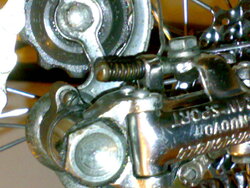TheCyclingRooster
Veteran
- Location
- Scarisbrick,Lancashire
Hi to you all out there. During the rebuilding of the recently acquired Benotto - a problem has arisen with the limitation associated with the Short Cage that is apparently 'the norm' on the old school campy kit.
I have found that the existing Nuovo Gran Sport is struggling to accommodate a 25T as part of a 13:15:17:19:21:23:25 screw-on and a triple 52:40:28. I am of the understanding that they have a maximum capacity of a 26T.
I am reluctant to shorten the chain any further in order to pull the cage backwards as this would leave the parallelogram in a perpendicular position and possibly putting excess strain on the chain and the system.
Without reverting to a modern indexed lever control unit and shifting it with the friction lever - which old school campy offers either a medium cage or better still - a long cage.
I am wishing to accommodate a 28T as part of a 7spd 14 - 28.
Would I be better sticking with the screw-on that was on the bike - a 6spd 13:14:16:18:21:26 ? I so what difference does the position of the 26T sprocket as number 6 make against having a 25T as number 7?
I have found that the existing Nuovo Gran Sport is struggling to accommodate a 25T as part of a 13:15:17:19:21:23:25 screw-on and a triple 52:40:28. I am of the understanding that they have a maximum capacity of a 26T.
I am reluctant to shorten the chain any further in order to pull the cage backwards as this would leave the parallelogram in a perpendicular position and possibly putting excess strain on the chain and the system.
Without reverting to a modern indexed lever control unit and shifting it with the friction lever - which old school campy offers either a medium cage or better still - a long cage.
I am wishing to accommodate a 28T as part of a 7spd 14 - 28.
Would I be better sticking with the screw-on that was on the bike - a 6spd 13:14:16:18:21:26 ? I so what difference does the position of the 26T sprocket as number 6 make against having a 25T as number 7?

 , then wrap capacity is obviously irrelevant to you.
, then wrap capacity is obviously irrelevant to you.